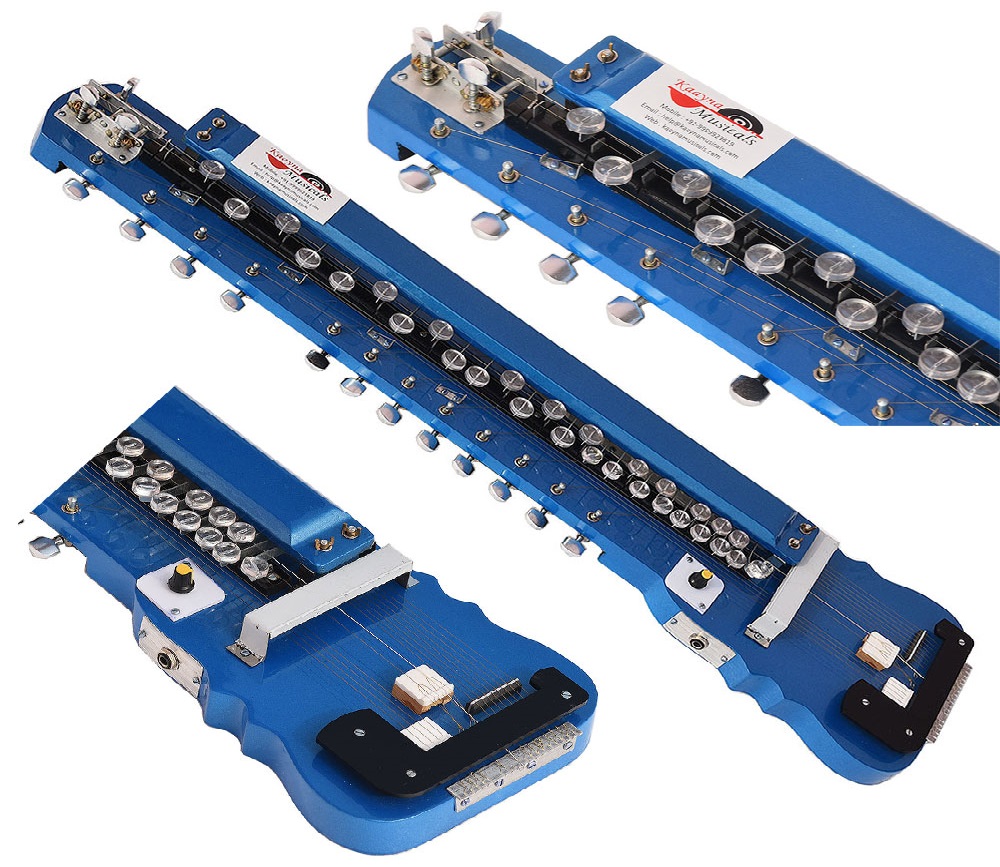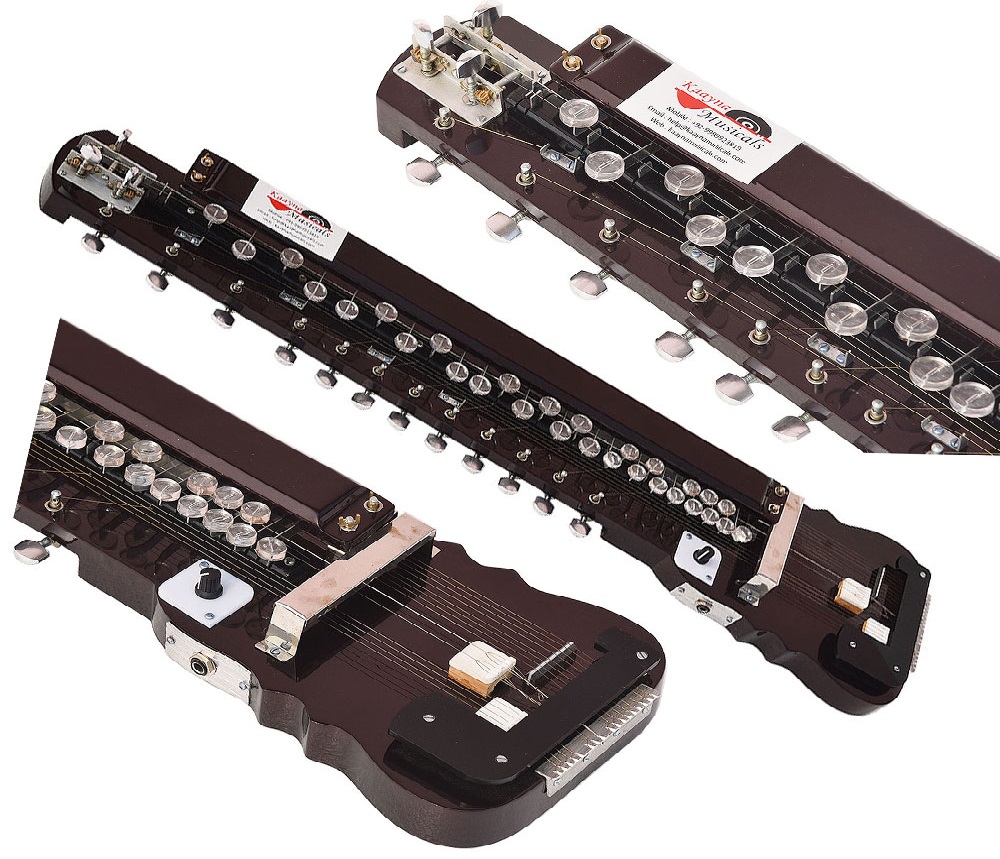Bulbul tarang
Keyboard Instruments
Asia
Between 1901 and present
Video
The Bulbul Tarang, also known as the “waves of nightingales,” is a captivating string instrument originating from South Asia. Often referred to as the Indian Banjo, this instrument combines elements of traditional string instruments with modern mechanical innovation. It is characterized by its unique design, which includes a typewriter-like keyboard that allows players to depress keys to alter the pitch of the strings. The instrument is typically housed in a wooden case, making it both portable and durable.
The Bulbul Tarang produces a melodic and rhythmic sound, often used to accompany vocal performances. Its strings are plucked or strummed, while the keys are pressed to create specific notes. This dual-action mechanism makes it an accessible yet versatile instrument for musicians of varying skill levels. The instrument’s name reflects its ability to produce cascading, bird-like melodies, reminiscent of a nightingale’s song.
Type of Instrument
The Bulbul Tarang belongs to the family of string instruments and can be classified as a typewriter zither. It is a hybrid instrument that incorporates features of traditional zithers and mechanical keyboards. The strings are tuned in unison or octaves, while drone strings provide harmonic support. This design enables the instrument to produce both melody and accompaniment simultaneously. Its classification as a keyboard zither highlights its innovation in blending mechanical and acoustic elements. Unlike purely acoustic instruments, the Bulbul Tarang uses keys to modify string tension, allowing for precise pitch control without requiring advanced finger techniques.
History
The origins of the Bulbul Tarang can be traced back to the early 20th century when it evolved from the Japanese Taishōgoto. This Japanese instrument was likely introduced to South Asia in the 1930s, where it underwent significant modifications to suit local musical traditions. Over time, it became an integral part of Indian and Pakistani music, earning its place as a legitimate instrument in these cultures. The adaptation of the Taishōgoto into the Bulbul Tarang reflects the blending of cultural influences during this period. In South Asia, the instrument was embraced for its ability to complement vocal performances and its adaptability to various musical styles. Its popularity spread beyond India and Pakistan to regions like Fiji, where it is known as “medolin,” and the Maldives, where it is called “kottafoshi.”
Types of Bulbul Tarang
There are several variations of the Bulbul Tarang, each tailored to specific musical needs:
Acoustic Bulbul Tarang: This is the traditional version with no electronic components. It relies entirely on acoustic resonance for sound production.
Electric Bulbul Tarang: An electrified version equipped with pickups for amplification, making it suitable for modern performances.
Shahi Baaja: A more complex variant that incorporates additional features like multiple tuning options and enhanced tonal range.
Portable Models: Smaller versions designed for ease of transport without compromising on sound quality.
Each type offers unique characteristics while maintaining the core functionality of producing melodic and rhythmic sounds.
Construction and Design
The construction of the Bulbul Tarang is both functional and artistic. It typically features a wooden body made from materials like pine, which provides resonance and durability. The instrument’s strings are arranged over a fretboard known as “Surpatti” in Hindi. Above this fretboard are keys resembling those on a typewriter, which are used to shorten or fret the strings. Modern versions of the Bulbul Tarang often include 10 to 14 strings divided into melody, bass, and drone sections. Some models also incorporate additional sympathetic strings that resonate harmonically with the main strings. The tuning mechanism allows for flexibility in pitch adjustment, catering to different musical scales or ragas. The design includes a metal handle for portability and locks for securing the case during transport. Accessories like plectrums and tuning keys are often included with the instrument. Despite its relatively simple appearance, the Bulbul Tarang’s construction demonstrates a balance between traditional craftsmanship and mechanical ingenuity.
Characteristics
The Bulbul Tarang is known for its distinctive sound and user-friendly design. Its primary characteristics include:
Melodic Versatility: The instrument can produce intricate melodies as well as harmonic accompaniments.
Ease of Play: The keyboard mechanism simplifies pitch alteration, making it accessible even for beginners.
Cultural Adaptability: It is used in various musical traditions across South Asia and beyond.
Portability: Its compact design makes it easy to carry and perform with.
Durability: The wooden body and metal components ensure longevity despite frequent use.
Playing Techniques and Sound Modifications
The bulbul tarang is played by striking its strings with a plectrum while simultaneously pressing the keys to modify the pitch. The keys, often resembling typewriter or piano keys, fret the strings to produce different notes. This dual action requires precision and coordination, as the player must synchronize rhythmic strumming with subtle key movements to achieve smooth transitions and melodic flow. The instrument is primarily designed for simple melodies and cannot perform advanced techniques like meend (glides) common in Indian classical music. However, skilled players can achieve microtonal variations and expressive modulations by adjusting their playing style. The drone strings add depth by resonating sympathetically, enriching the sound with a harmonic backdrop. Tuning adjustments, such as using bronze or brass strings or altering string gauges, allow players to explore a wider tonal range and customize the instrument’s sound to complement their vocals or specific compositions.
Applications in Music
The bulbul tarang has historically been a versatile instrument in Indian music. It was widely used from the 1950s to the 1970s in film music, bhajans (devotional songs), ghazals (lyrical poetry), qawwalis (Sufi devotional songs), and mehfils (intimate musical gatherings). Its affordability and ease of learning made it popular among beginners and folk musicians. Additionally, it served as a gateway for young musicians exploring instrumental music. Renowned composers like R.D. Burman incorporated the bulbul tarang into their works, showcasing its unique tonal qualities. Some musicians have also attempted to adapt it for classical renditions, performing Hindustani ragas on this instrument. Despite its decline in mainstream popularity due to advancements in electronic instruments and recording technology, it remains cherished in niche genres and regional traditions. Efforts by contemporary musicians aim to revive its status as both an accompaniment and a solo instrument2.
Most Influential Players
Several musicians have contributed significantly to the bulbul tarang’s legacy. Composer R.D. Burman is one of the most notable figures who extensively used the instrument in his compositions during its heyday. Rajendra Naik, a modern exponent of the bulbul tarang, has worked tirelessly to adapt it for classical music over the past 25 years. His repertoire includes Hindustani classical ragas and hundreds of other pieces that highlight the instrument’s potential for intricate melodies. Naik has collaborated with manufacturers to create custom versions of the instrument, such as the “Pratham Tarang,” which enhances its capabilities for classical performance. His efforts have brought attention to the bulbul tarang through solo concerts in India and abroad, inspiring a new generation of musicians to explore its possibilities2.
Maintenance and Care
Proper maintenance is essential to preserve the bulbul tarang’s functionality and sound quality. Here are some key care tips:
Cleaning: Use a dry, soft cloth for dusting and a damp cloth for cleaning. Avoid abrasives that could damage the surface.
Environmental Protection: Keep the instrument away from extreme temperatures, high humidity, or overly dry conditions to prevent warping or cracking.
String Maintenance: Tune strings slowly to avoid breakage and ensure they are neither too tight nor too loose.
Key Adjustments: If keys stick or fail to rebound due to humidity-induced swelling or misalignment, gently wiggle them or use fine-grit sandpaper for adjustments.
Spring Arm Repairs: If a key loses its spring action, reset the spring arm by accessing it through the underside of the keyboard.
Regular care not only extends the lifespan of the instrument but also maintains its tonal richness and playability3.
Cultural Significance
The bulbul tarang holds a unique place in Indian musical culture. Its name translates to “waves of nightingales,” reflecting its melodious sound that resonates with folk traditions. Originating from Japan’s taisho koto in the early 20th century, it became an integral part of Indian music after being adapted locally. In addition to its role in popular music genres like film songs and devotional music, it has been a favored choice for amateur musicians due to its affordability and simplicity. The bulbul tarang has also been likened to instruments like the autoharp or banjo in terms of cultural impact—accessible yet capable of producing profound musical expressions.
Despite facing challenges from modern electronic instruments, it continues to symbolize creativity and nostalgia for many enthusiasts. Efforts by dedicated musicians and cultural organizations aim to ensure that this “Indian banjo” remains an enduring part of India’s rich musical heritage
FAQ
What is the history of the Bulbul Tarang?
The Bulbul Tarang, meaning "waves of nightingale," originated in India in the early 20th century. It evolved from the Japanese Taishogoto and became popular in folk and light music. The instrument blends features of a typewriter-like key mechanism with plucked strings. It has since spread to various South Asian and global music traditions.
What materials are used in the construction of a Bulbul Tarang?
The Bulbul Tarang is typically made of a wooden body, with metal strings and keys. The frets are often crafted from brass, while tuning pegs and bridges may be wooden or plastic. Some modern versions feature electronic pickups for amplification. The instrument's lightweight construction makes it portable and easy to play.
How is the Bulbul Tarang played?
The Bulbul Tarang is played by pressing keys to fret the strings while strumming with a pick or fingers. It produces a bright, resonant sound reminiscent of a zither or harmonium. Players can create melodies by changing finger positions and strumming patterns. Some versions include electronic amplification for enhanced sound projection.
 Links
Links
References
Other Instrument
Categories



















